华中科技大学生理学2015年考博真题考博试卷
- 格式:doc
- 大小:40.00 KB
- 文档页数:2
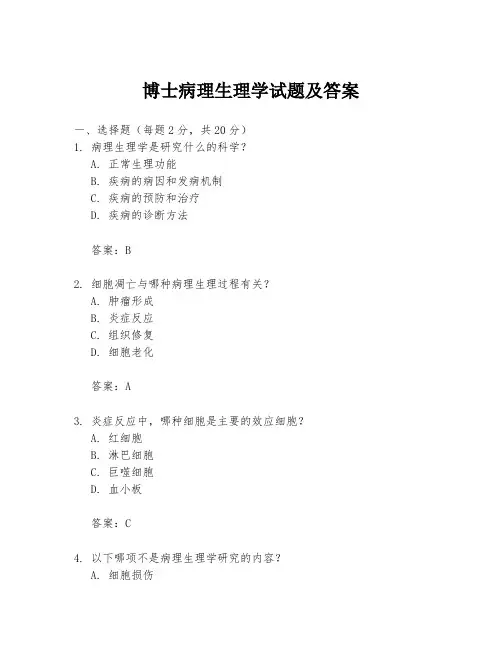
博士病理生理学试题及答案一、选择题(每题2分,共20分)1. 病理生理学是研究什么的科学?A. 正常生理功能B. 疾病的病因和发病机制C. 疾病的预防和治疗D. 疾病的诊断方法答案:B2. 细胞凋亡与哪种病理生理过程有关?A. 肿瘤形成B. 炎症反应C. 组织修复D. 细胞老化答案:A3. 炎症反应中,哪种细胞是主要的效应细胞?A. 红细胞B. 淋巴细胞C. 巨噬细胞D. 血小板答案:C4. 以下哪项不是病理生理学研究的内容?A. 细胞损伤B. 细胞死亡C. 细胞分裂D. 细胞再生答案:C5. 病理生理学中的“应激反应”是指什么?A. 身体对外界刺激的适应性反应B. 身体对疾病状态的防御性反应C. 身体对感染的免疫反应D. 身体对药物的代谢反应答案:A二、判断题(每题1分,共10分)1. 病理生理学是医学的一个分支,主要研究疾病的病因、发病机制和转归。
(对)2. 病理生理学与临床病理学是同一概念。
(错)3. 细胞凋亡是一种病理性死亡过程。
(错)4. 炎症是机体对损伤因子的一种防御性反应。
(对)5. 病理生理学研究的重点是疾病的预防和治疗。
(错)三、简答题(每题5分,共30分)1. 简述病理生理学的主要研究内容。
答案:病理生理学主要研究疾病的发生、发展过程,包括病因、发病机制、病理变化以及机体对疾病的反应和适应。
2. 描述细胞凋亡与细胞坏死的区别。
答案:细胞凋亡是一种程序化的细胞死亡过程,通常没有炎症反应,是机体正常生理过程的一部分。
而细胞坏死是非程序化的,通常由于外界因素如缺氧、感染等引起,伴随炎症反应。
3. 炎症反应的四个主要表现是什么?答案:炎症反应的四个主要表现是红、肿、热、痛。
4. 什么是病理性应激反应?它在疾病中的作用是什么?答案:病理性应激反应是机体在疾病状态下对内外环境变化的适应性反应。
它有助于机体抵抗损伤,但过度或不适当的应激反应可能导致疾病的发展和恶化。
四、论述题(每题15分,共30分)1. 论述病理生理学在临床诊断和治疗中的重要性。
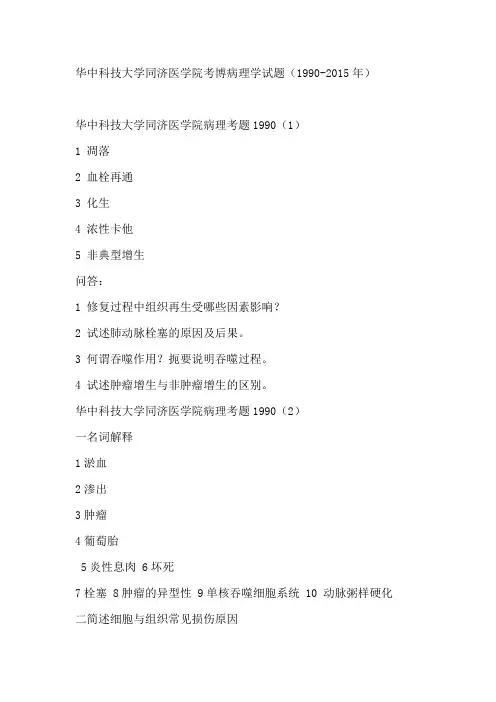
华中科技大学同济医学院考博病理学试题(1990-2015年)华中科技大学同济医学院病理考题1990(1)1 凋落2 血栓再通3 化生4 浓性卡他5 非典型增生问答:1 修复过程中组织再生受哪些因素影响?2 试述肺动脉栓塞的原因及后果。
3 何谓吞噬作用?扼要说明吞噬过程。
4 试述肿瘤增生与非肿瘤增生的区别。
华中科技大学同济医学院病理考题1990(2)一名词解释1淤血2渗出3肿瘤4葡萄胎5炎性息肉 6坏死7栓塞 8肿瘤的异型性 9单核吞噬细胞系统 10 动脉粥样硬化二简述细胞与组织常见损伤原因三试述良性高血压时心和肾的病理变化四试述脓肿的病因,病理变化和结局五原发肺结核与继发肺结核的病理变化有何不同?华中科技大学同济医学院病理考题1991(1)1 试述凝固性坏死、液化性坏死、干酪样坏死和脂肪坏死的形态学特点及其相互区别。
2 试述畸胎瘤和癌肉瘤的异同点。
3 何谓肉芽肿性炎?常见病因。
各举两例说明其形态结构和结局。
4 纤维素性炎发生与哪些器官?哪些疾病(至少两种以上)?形态学有何特点?华中科技大学同济医学院病理考题1991(2)一名词解释1吞噬溶酶体 2蜂窝织炎 3液化性坏死 4血栓形成 5梗死6免疫缺陷病 7结核结节 8尘肺 9肿瘤的异型性 10慢性萎缩性肾炎二举例说明恶性肿瘤的扩散途径三试述血吸虫性肝硬变的病变特征和临床表现四试述细菌性肺炎的病变特征华中科技大学同济医学院病理考题1992一名词解释1细胞水变性 2微血栓 3蜂窝织炎 4缩窄性心包炎 5结核病6原位癌 7浆液性炎症 8粥瘤 9固缩坏死(凋落) 10交界性肿瘤二何谓坏疽?坏疽分哪几种类型?各型病变有何特征?三简述急性炎症和结局四试述急性(普通型)病理型肝炎的病理变化及临床联系五简述弥漫性新月体肾炎的病理变化及临床病理联系华中科技大学同济医学院病理考题1993一名词解释1瘢痕组织 2风湿小节 3肠上皮化生 4混合血栓 5化脓性炎症6肿瘤的转移 7脑软化 8硅(矽)结节 9肝细胞碎片状坏死 10脓毒血症二试述肿瘤的生长方式及其临床意义三试述支气管炎的病理变化及其主要临床症状与病变的关系四简述结核病基本病变的转化规律五试述血栓对机体的影响,并各举一例加以说明同济医科大学一九九三年攻读博士学位研究生入学试题基础课:病理学一.解释常用病理学名词(每小题4分,共40分)1、肿瘤的异型性2、毛玻璃样肝细胞3、干酪样坏死4、栓塞 5、心肌梗死 6、嗜神经细胞现象 7、脂肪变性 8、organization 9、tuberculoma 10、化生二.何谓癌前病变?列举各种类型癌前病变并简要说明之。
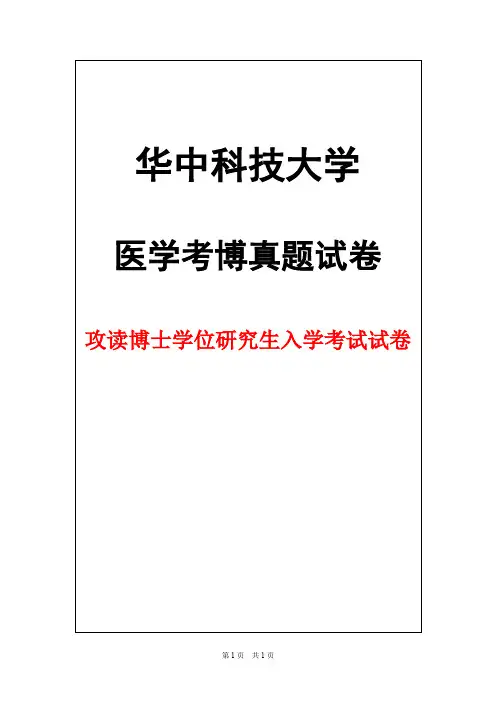
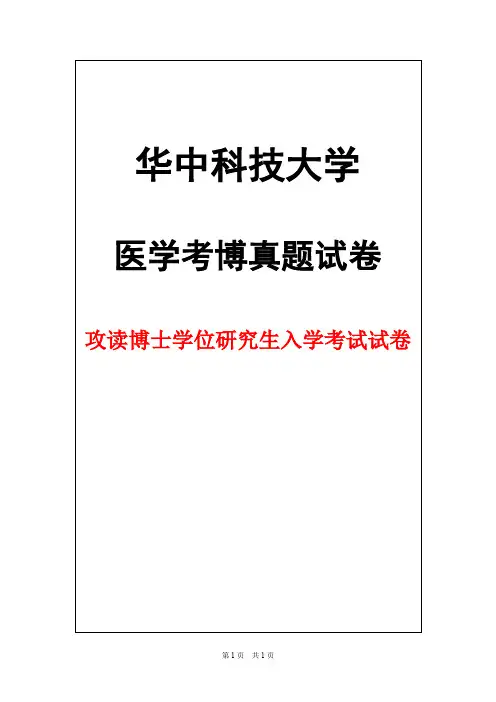
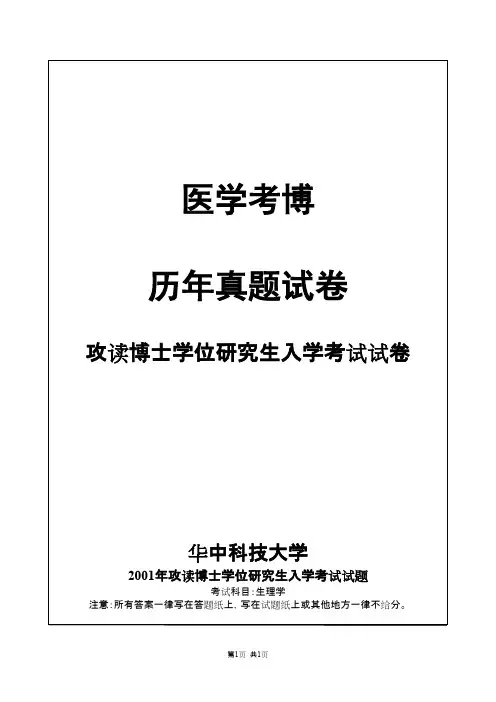
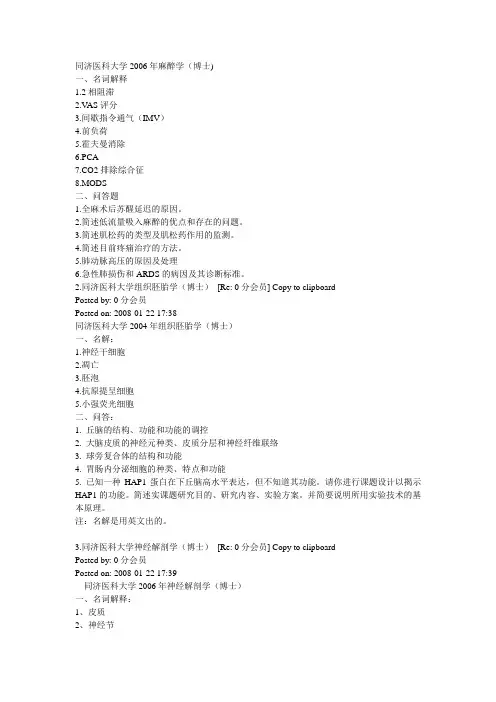
同济医科大学2006年麻醉学(博士)一、名词解释1.2相阻滞2.V AS评分3.间歇指令通气(IMV)4.前负荷5.霍夫曼消除6.PCA7.CO2排除综合征8.MODS二、问答题1.全麻术后苏醒延迟的原因。
2.简述低流量吸入麻醉的优点和存在的问题。
3.简述肌松药的类型及肌松药作用的监测。
4.简述目前疼痛治疗的方法。
5.肺动脉高压的原因及处理6.急性肺损伤和ARDS的病因及其诊断标准。
2.同济医科大学组织胚胎学(博士)[Re: 0分会员] Copy to clipboardPosted by: 0分会员Posted on: 2008-01-22 17:38同济医科大学2004年组织胚胎学(博士)一、名解:1.神经干细胞2.凋亡3.胚泡4.抗原提呈细胞5.小强荧光细胞二、问答:1. 丘脑的结构、功能和功能的调控2. 大脑皮质的神经元种类、皮质分层和神经纤维联络3. 球旁复合体的结构和功能4. 胃肠内分泌细胞的种类、特点和功能5. 已知一种HAP1蛋白在下丘脑高水平表达,但不知道其功能。
请你进行课题设计以揭示HAP1的功能。
简述实课题研究目的、研究内容、实验方案。
并简要说明所用实验技术的基本原理。
注:名解是用英文出的。
3.同济医科大学神经解剖学(博士)[Re: 0分会员] Copy to clipboardPosted by: 0分会员Posted on: 2008-01-22 17:39同济医科大学2006年神经解剖学(博士)一、名词解释:1、皮质2、神经节3、纤维束4、internal capsule5、corpus striatum6、medial lemniscus7、?8、broca区9、锥体系10记不起来了,也很简单二、问答题:1.小脑的分叶及纤维联系2.尺神经损伤的表现及原因3.交感神经节前纤维及节后纤维的走向4.脑干一般内脏运动核的功能及纤维联系5.?6.?4.同济医科大学肿瘤学(博士)[Re: 0分会员] Copy to clipboardPosted by: 0分会员Posted on: 2008-01-22 17:40同济医科大学2006年肿瘤学(博士)一、名解(4*5)20分1 IGRT2 GCP3 VEGF4 TBI5 NCCN二、问答题80分1.简述肿瘤基因治疗的策略?152.简述霍杰金淋巴瘤的临床分期及治疗原则?153.WHO疼痛治疗原则?154.论述化疗药物机制和细胞周期的关系?155.鼻咽癌TNM分期,临床分期,治疗原则和技术?205.同济医科大学考博历年真题感染专业2005年试题[Re: 0分会员] Copy to clipboard Posted by: 0分会员Posted on: 2008-01-22 17:40同济医科大学考博历年真题感染专业2005年试题一、名词解释(每题5分)1.incudation period2.septicemia3.rabies4.nosocomial infection5.cholera二、问答题(每题20分)1.肝性脑病的发病机制及治疗原则2.HIV的治疗原则和临床表现3.丙型肝炎的基因分型及抗病毒治疗方案三、选答题(二选一)(15分)1.试述肝相关干细胞研究的现状及展望2.简述细菌对抗菌药产生耐药的发病机制6.同济医科大学细胞生物学(博士)[Re: 0分会员] Copy to clipboardPosted by: 0分会员Posted on: 2008-01-22 17:41同济医科大学2003年细胞生物学(博士)一、名词解释(共10小题,每题4分,共40分)1.nuclear skeleton2.kinetochore3.Signal Sequence4.stem cell5.molecular chaperon6.cyclin7.核孔复合体核篮模型8.膜泡运输9.微丝结合蛋白10.蛋白酶体二、综合题(共60分)1.试述溶酶体的形态结构、化学组成、形成的主要途径及功能。
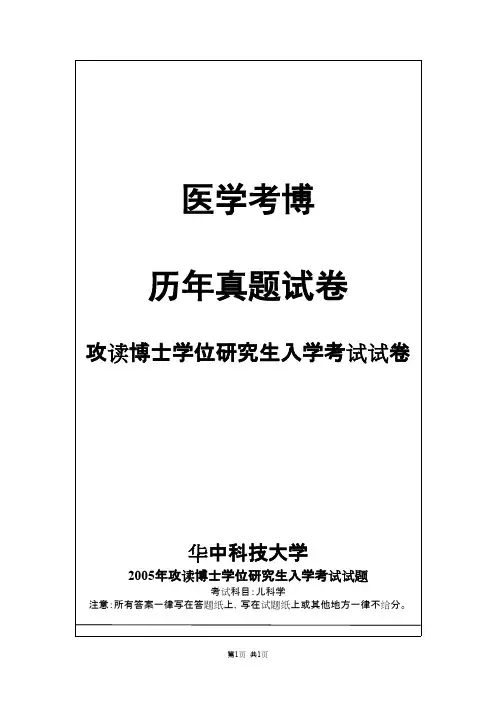
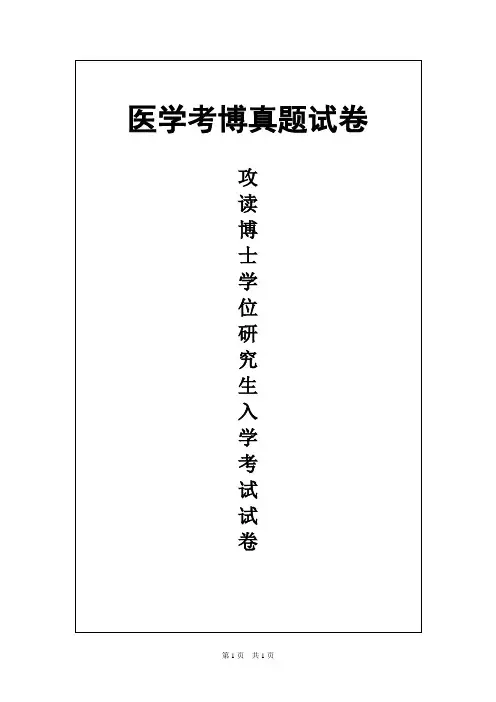
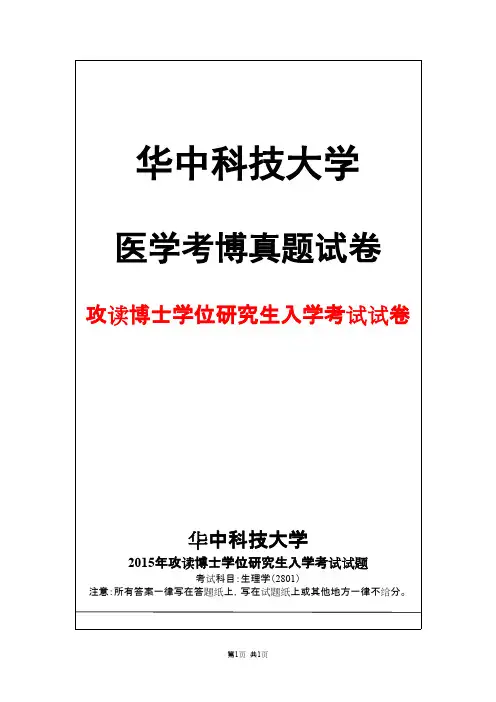
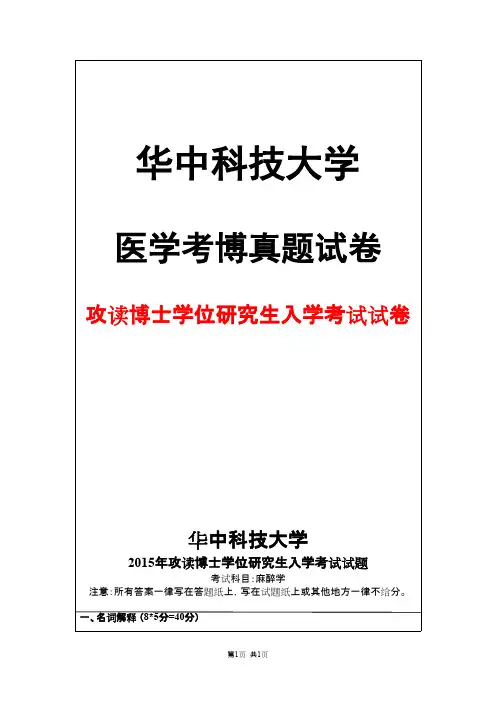
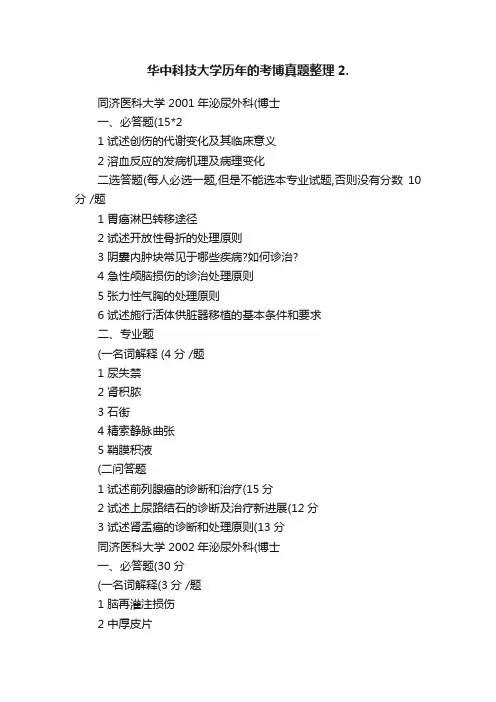
华中科技大学历年的考博真题整理2.同济医科大学 2001年泌尿外科(博士一、必答题(15*21 试述创伤的代谢变化及其临床意义2 溶血反应的发病机理及病理变化二选答题(每人必选一题,但是不能选本专业试题,否则没有分数10分 /题1 胃癌淋巴转移途径2 试述开放性骨折的处理原则3 阴囊内肿块常见于哪些疾病?如何诊治?4 急性颅脑损伤的诊治处理原则5 张力性气胸的处理原则6 试述施行活体供脏器移植的基本条件和要求二、专业题(一名词解释 (4分 /题1 尿失禁2 肾积脓3 石街4 精索静脉曲张5 鞘膜积液(二问答题1 试述前列腺癌的诊断和治疗(15分2 试述上尿路结石的诊断及治疗新进展(12分3 试述肾盂癌的诊断和处理原则(13分同济医科大学 2002年泌尿外科(博士一、必答题(30分(一名词解释(3分 /题1 脑再灌注损伤2 中厚皮片(二问答题(12分 /题1创伤后组织修复过程分为哪几个阶段?各阶段的主要特点是什么?2 试述肿瘤浸润与转移过程中的相关因素专业题一、名词解释(3分 /题1 尿频2 PSA3 少尿 /无尿4 肾积水5 皮质醇症二、问答题1简述尿失禁的分类及常见原因(10分2 男性前尿道损伤的治疗原则(15分3 膀胱移行细胞癌的临床分期?表浅膀胱癌的治疗原则(15分4 良性前列腺增生的诊断和鉴别诊断(15分同济医科大学 2003年泌尿外科(博士一、必答题(30分(一名词解释(5*21 成人型呼吸窘迫综合征(ARDS2全身性炎症反应综合征(SIRS3 痈4 海绵状血管瘤5 负氮平衡(二问答题(5*61 灭菌与消毒有何区别?2 高钾血症的原因有哪些?如何诊断和处理?3 简述肠外营养有哪些常见的并发症?如何处理?4 简述外科如何选择和使用抗菌药物?5 创伤后组织修复分几个阶段?简述其修复过程?二、专业题(一名词解释(4*31 膀胱破裂的导尿实验2 K抗原3 前列腺痛4 肾皮质结核(二问答题(8*61 什么叫尿频,引起尿频的原因有哪些?2 叙述多囊肾的病因及分类3 叙述分段尿及前列腺培养检查方法4 叙述双侧上尿路结石的手术原则5 叙述膀胱镜下各期膀胱肿瘤的肉眼特征6 叙述肾积水的常见原因7 原发性醛固酮增多症有那些临床表现?8 叙述精索静脉曲张的发病机理同济医科大学 2005年泌尿外科(博士公共部分:一、名解SIADH SIRS二、问答:1、成分输血的种类及适应症2、肠源性感染的发病机制3、代酸的分型及常见原因泌外:一、名解肾积脓浅表性膀胱肿瘤Cushing`s syndrome Peyronie disease二、问答1、简述 BPH 的病生特、各自引起的临床症状和治疗方案2、上尿路结石的微创方法及适应症3、前列腺癌的治疗4、肾结核的鉴别诊断同济医科大学 2006年泌尿外科(博士外科公共部分名词解释 :基因诊断条件性感染CARS问答 :1、肠内营养的适应症2、自体输血的适应症及禁忌症泌尿外科部分名词解释 :肾后性肾功衰微创泌尿外科充盈性尿失禁尿崩症问答 :1、输尿管反流的原因危害及处理2、泌尿系感染与妇科生理变化的关系3、 KUB 的作用4、膀胱造瘘的并发症及预防27. 同济医科大学分子生物学(博士[Re: 0分会员] Copy to clipboard Posted by: 0分会员Posted on: 2008-01-22 17:57同济医科大学 2001年分子生物学(博士一、英汉互译下列名词,并加以解释 (30分1、 transposable element2、 restriction enzyme3、 derepression4、 gene therapy5、 calmo dulin6、操纵子7、反式作用因子8、基因组9、原癌基因10、多克隆位点二、试述反式作用因子的结构特征及作用方式 (20分三、试述 2型限制酶的功能与特性 (20分四、试述影响原核基因转录的因素 (20分五、试述病毒核酸的结构特点 (10分华中科技大学同济医学院 2002年攻读博士学位研究生入学考试试题考试科目:分子生物学(基础课科目代码:811一名词解释并写出对应的英文名词(共10小题,每小题5分,共50分1. 克隆载体2. 表达载体3. 假基因4. 微卫星序列5. 回文结构6. 启动子7. 癌基因 8. 多克隆位点 9. 增强子 10. 开放阅读框架二问答题(共 3小题,每小题 10分,共 30分1. 若要获得 IL-2的基因工程产品,你应该怎么做?2. 真核细胞中基因表达的特异性转录调控因子是指什么?根据它们的结构特征可以分为哪些类型?它们和 DNA 相互识别的原理是什么?3. 简述细胞内癌基因激活的方式?三选答题(任选 2小题,每小题 10分,共 20分1. 简述基因治疗中转移外源基因至体内的非病毒和病毒途径的主要原理2. 请你评价一下人类基因组计划(HGMP 完成的意义(蒲А⒕ ? 济和社会的??BR>3.分子生物学实验中所涉及的引物有哪几种,各有什么用途和特点?4. 简述 3~4种 PCR 衍生技术及其应用同济医科大学 2003年分子生物学(博士一名词解释并写出对应的英文名词(共10小题,每小题5分,共50分1. 克隆载体2. 表达载体3. 断裂基因4. 双脱氧核苷酸(简单5. 多克隆位点6. 启动子7. 癌基因8. 核糖体结合位点(简单9. 增强子10. 开放阅读框架二问答题(共3小题,每小题10分,共30分1. 什么是分子克隆技术?它的主要步骤是什么?2. 真核细胞和原核细胞基因表达在转录水平上调控的特点。
Since Would War II considerable advances have been made in the area of health-care services. These include better access to health care (particularly for the poor and minorities), improvements in physical plants, and increased numbers of physicians and other health personnel. All have played a part in the recent improvement in life expectancy. But there is mounting criticism of the large remaining gaps in access, unbridled cost inflation, the further fragmentation of service, excessive indulgence in wasteful high-technology “gadgeteering,” and a breakdown in doctor-patient relationships. In recent years proposed panaceas and new programs, small and large, have proliferated at a feverish pace and disappointments multiply at almost the same rate. This has led to an increased pessimism—“everything has been tried and nothing works”—which sometimes borders on cynicism or even nihilism.It is true that the automatic “pass through” of rapidly spiraling costs to government and insurance carriers, which was set in a publicized environment of “the richest nation in the world,” produced for a time a sense of unlimited resources and allowed to develop a mood whereby every practitioner and institution could “do his own thing” without undue concern for the “Medical Commons.” The practice of full-cost reimbursement encouraged capital investment and now the industry is overcapitalized. Many cities have hundreds of excess hospital beds; hospitals have proliferated a superabundance of high-technology equipment; and structural ostentation and luxury were the order of the day. In any given day, one-fourth of all community beds are vacant; expensive equipment is underused or, worse, used unnecessarily. Capital investment brings rapidly rising operating costs.Yet, in part, this pessimism derives from expecting too much of health care. It must be realized that care is, for most people, a painful experience, often accompanied by fear and unwelcome results. Although there is vast room for improvement, health care will always retain some unpleasantness and frustration. Moreover, the capacities of medical science are limited. Humpty Dumpty cannot always be put back together again. Too many physicians are reluctant to admit their limitations to patients; too many patients and families are unwilling to accept such realities. Nor is it true that everything has been tried and nothing works, as shown by the prepaid group practice plans of the Kaiser Foundation and at Puget Sound. In the main, however, such undertakings have been drowned by a veritable flood of public and private moneys which have supported and encouraged the continuation of conventional practices and subsidized their shortcomings on a massive, almost unrestricted scale. Except for the most idealistic and dedicated, there were no incentives to seek change or to practice self-restraint or frugality. In this atmosphere, it is not fair to condemn as failures all attempted experiments; it may be more accurate to say many never had a fair trial.1. The author implies that the Kaiser Foundation and Puget Sound plans (lines47-48) differed from other plans by(A) encouraging capital investment(B) requiring physicians to treat the poor(C) providing incentives for cost control(D) employing only dedicated and idealistic doctors(E) relying primarily on public funding2. The author mentions all of the following as consequences of full-costreimbursement EXCEPT(A) rising operating costs(B) underused hospital facilities(C) overcapitalization(D) overreliance on expensive equipment(E) lack of services for minorities3. The tone of the passage can best be described as(A) light-hearted and amused(B) objective but concerned(C) detached and unconcerned(D) cautious but sincere(E) enthusiastic and enlightened4. According to the author, the “pessimism” mentioned at line 35 is partlyattributable to the fact that(A) there has been little real improvement in health-care services(B) expectations about health-care services are sometimes unrealistic(C) large segments of the population find it impossible to get access tohealth-care services(D) advances in technology have made health care service unaffordable(E) doctors are now less concerned with patient care5. The author cites the prepaid plans in lines 46-48 as(A) counterexamples to the claim that nothing has worked(B) examples of health-care plans that were over-funded(C) evidence that health-care services are fragmented(D) proof of the theory that no plan has been successful(E) experiments that yielded disappointing results6. It can be inferred that the sentence “Humpty Dumpty cannot always be put backtogether again” means that(A) the cost of health-care services will not decline(B) some people should not become doctors(C) medical care is not really essential to good health(D) illness is often unpleasant and even painful(E) medical science cannot cure every ill7. With which of the following descriptions of the system for the delivery ofhealth-care services would the author most likely agree?(A) It is biased in favor of doctors and against patients.(B) It is highly fragmented and completely ineffective(C) It has not embraced new technology rapidly enough(D) It is generally effective but can be improved(E) It discourages people from seeking medical care8. Which of the following best describes the logical structure of the selection?(A) The third paragraph is intended as a refutation of the first and secondparagraphs.(B) The second and third paragraphs explain and put into perspective the pointsmade in the first paragraph.(C) The second and third paragraphs explain and put into perspective the pointsmade in the first paragraph.(D) The first paragraph describes a problem, and the second and third paragraphspresent two horns of a dilemma.(E) The first paragraph describes a problem, the second its causes, and the third apossible solution.9. The author’s primary concern is to(A) criticize physicians and health-care administrators for investing in techno-logically advanced equipment(B) examine some problems affecting delivery of health-care services and assesstheir severity(C) defend the medical community from charges that health-care has notimproved since World War II(D) analyze the reasons for the health-care industry’s inability to provide qualitycare to all segments of the population(E) describe the peculiar economic features of the health-care industry that are thecauses of spiraling medical costs1. C2. E3. B4. B5. A6. E7. D8. C9. B 10.Behavior is one of two general responses available to endothermic (warm-blooded) species for the regulation of body temperature, the other being innate (reflexive) mechanisms of heat production and heat loss. Human beings rely primarily on the first to provide a hospitable thermal microclimate for themselves, in which the transfer of heat between the body and the environment is accomplished with minimal involvement of innate mechanisms of heatproduction and loss. Thermoregulatory behavior anticipates hyperthermia, and the organism adjusts its behavior to avoid becoming hyperthermic: it removes layers of clothing, it goes for a cool swim, etc. The organism can also respond to changes in the temperature of the body core, as is the case during exercise; but such responses result from the direct stimulation of thermoreceptors distributed widely within the central nervous system, and the ability of these mechanisms to help the organism adjust to gross changes in its environment is limited.Until recently it was assumed that organisms respond to microwave radiation in the same way that they respond to temperature changes caused by other forms of radiation. After all, the argument runs, microwaves are radiation and heat body tissues. This theory ignores the fact that the stimulus to a behavioral response is normally a temperature change that occurs at the surface of the organism. The thermoreceptors that prompt behavioral changes are located within the first millimeter of the skin’s surface, but the energy of a microwave field may be selectively deposited in deep tissues, effectively bypassing these thermoreceptors, particularly if the field is at near-resonant frequencies. The resulting temperature profile may well be a kind of reverse thermal gradient in which the deep tissues are warmed more than those of the surface. Since the heat is not conducted outward to the surface to stimulate the appropriate receptors, the organism does not “appreciate” this stimulation in the same way that it “appreciates” heating and cooling of the skin. In theory, the internal organs of a human being or an animal could be quite literally cooked well-done before the animal even realizes that the balance of its thermomicroclimate has been disturbed.Until a few years ago, microwave irradiations at equivalent plane-wave power densities of about 100 mW/cm2 were considered unequivocally to produce “thermal” effects; irradiations within the range of 10 to 100 mW/cm2 might or might not produce “thermal” effects; while effects observed at power densities below 10 mW/cm2 were assumed to be “nonthermal” in nature. Experiments have shown this to be an oversimplification, and a recent report suggests that fields as weak as 1 mW/cm2 can be thermogenic. When the heat generated in the tissues by an imposed radio frequency (plus the heat generated by metabolism) exceeds the heat-loss capabilities of the organism, the thermoregulatory system has been compromised. Yet surprisingly, not long ago, an increase in the internal body temperature was regarded merely as “evidence” of a thermal effect.1. The author is primarily concerned with(A) showing that behavior is a more effective way of controlling bodilytemperature than innate mechanisms(B) criticizing researchers who will not discard their theories about the effects ofmicrowave radiation on organisms(C) demonstrating that effects of microwave radiation are different from those ofother forms of radiation(D) analyzing the mechanism by which an organism maintains its bodilytemperature in a changing thermal environment(E) discussing the importance of thermoreceptors in the control of the internaltemperature of an organism2. The author makes which of the following points about innate mechanisms forheat production?I. They are governed by thermoreceptors inside the body of the organismrather than at the surface.II. They are a less effective means of compensating for gross changes in temperature than behavioral strategies.III. They are not affected by microwave radiation.(A) I only(B) I and II only(C) I and III only(D) II and III only(E) I, II, and III3. Which of the following would be the most logical topic for the author to take upin the paragraph following the final paragraph of the selection?(A) A suggestion for new research to be done on the effects of microwaves onanimals and human beings(B) An analysis of the differences between microwave radiation(C) A proposal that the use of microwave radiation be prohibited because it isdangerous(D) A survey of the literature on the effects of microwave radiation on humanbeings(E) A discussion of the strategies used by various species to control hyperthermia4. The author’s strategy in lines 39-42 is to(A) introduce a hypothetical example to dramatize a point(B) propose an experiment to test a scientific hypothesis(C) cite a case study to illustrate a general contention(D) produce a counterexample to disprove an opponent’s theory(E) speculate about the probable consequences of a scientific phenomenon5. The author implies that the proponents of the theory that microwave radiationacts on organisms in the same way as other forms of radiation based theirconclusions primarily on(A) laboratory research(B) unfounded assumption(C) control group surveys(D) deductive reasoning(E) causal investigation6. The tone of the passage can best be described as(A) genial and conversational(B) alarmed and disparaging(C) facetious and cynical(D) scholarly and noncommittal(E) scholarly and concerned7. The author is primarily concerned with(A) pointing out weaknesses in a popular scientific theory(B) developing a hypothesis to explain a scientific phenomenon(C) reporting on new research on the effects of microwave radiation(D) criticizing the research methods of earlier investigators(E) clarifying ambiguities in the terminology used to describe a phenomenon1. C2. B3. A4. A5. B6. E7. A8.9.10.Agricultural progress provided the stimulus necessary to set off economic expansion in medieval France. As long as those who worked the land were barely able to ensure their own subsistence and that of their landlords, all other activities had to be minimal, but when food surpluses increased, it became possible to release more people for governmental, commercial, religious and cultural pursuits.However, not all the funds from the agricultural surplus were actually available for commercial investment. Much of the surplus, in the form of food increases, probably went to raise the subsistence level; an additional amount, in the form of currency gained from the sale of food, went into the royal treasury to be used in waging war. Although Louis VII of France levied a less crushing tax burden on his subjects than did England’s Henry II, Louis VII did spend great sums on an unsuccessful crusade, and his vassals—both lay and ecclesiastic—took over spending where their sovereign stopped. Surplus funds were claimed both by the Church and by feudal landholders, whereupon cathedrals and castles mushroomed throughout France.The simultaneous progress of cathedral building and, for instance, vineyard expansion in Bordeaux illustrates the very real competition for available capital between the Church and commercial interests; the former produced inestimable moral and artistic riches, but the latter had a stronger immediate impact upon gross national product. Moreover, though all wars by definition are defensive, the frequent crossings of armies that lived off the land and impartially burned all the huts and barns on their path consumed considerable resources.Since demands on the agricultural surplus would have varied from year to year, we cannot precisely calculate their impact on the commercial growth of medieval France. But we must bear that impact in mind when estimating the assets that were likely to have been available for investment. No doubt castle and cathedral building was not totally barren of profit (for the builders, that is), and it produced intangible dividends of material and moral satisfaction for the community. Even wars handed back a fragment of what they took, at least to a few. Still, we cannot place on the same plane a primarily destructive activity and a constructive one, norexpect the same results from a new bell tower as from a new water mill. Above all, medieval France had little room for investment over and above the preservation of life. Granted that war cost much less than it does today, that the Church rendered all sorts of educational and recreational services that were unobtainable elsewhere, and that government was far less demanding than is the modern state—nevertheless, for medieval men and women, supporting commercial development required considerable economic sacrifice.1. According to the passage, agricultural revenues in excess of the amount neededfor subsistence were used by medieval kings to(A) patronize the arts(B) sponsor public recreation(C) wage war(D) build cathedrals(E) fund public education2. According to the passage, which of the following was an important source ofrevenue in medieval France?(A) Cheese(B) Wine(C) Wool(D) Olive oil(E) Veal3. The passage suggests that which of the following would have reduced the assetsimmediately available for commercial investment in medieval France?I. Renovation of a large cathedralII. A sharp increase in the birth rateIII. An invasion of France by Henry II(A) III only(B) I and II only(C) I and III only(D) II and III only(E) I, II, and III4. It can be inferred from the passage that more people could enter government andthe Church in medieval France because(A) the number of individual landholdings in heavily agricultural areas wasbeginning to increase(B) an increase in the volume of international trade had brought an increase in thepopulation of cities(C) a decrease in warfare had allowed the king to decrease the size of the army(D) food producers could grow more food than they and their families needed tosurvive(E) landlords were prospering and thus were demanding a smaller percentage oftenants’ annual yields5. The author implies that the reason we cannot expect the same results from a newbell tower as from a new water mill is that(A) bell towers yield an intangible dividend(B) bell towers provide material satisfaction(C) water mills cost more to build than bell towers(D) water mills divert funds from commerce(E) water mills might well be destroyed by war6. The author of the passage most probably bases his central argument on which ofthe following theoretical assumptions often made by economists?(A) Different people should be taxed in proportion to the benefit they can expectto receive from public activity.(B) Perfect competition exists only in the case where no farmer, merchant, orlaborer controls a large enough share of the total market to influence marketprice.(C) A population wealthy enough to cut back its rate of consumption can funnelthe resulting savings into the creation of capital.(D) A full-employment economy must always, to produce one good, give upproducing another good.(E) There is a universal tendency for population, unless checked by food supply,to increase in a geometric progression.7. The author suggests that commercial expansion in medieval France “requiredconsiderable economic sacrifice” (lines 59-60) primarily for which of thefollowing reasons?(A) Cathedrals cost more to build and rebuild than did castles.(B) The numerous wars fought during the period left the royal treasury bankrupt.(C) Louis VII levied a more crushing tax burden on his subjects than did HenryII.(D) Although much of the available surplus had been diverted into vineyardexpansion, the vineyards had not yet begun to produce.(E) Although more food was being produced, the subsistence level was not veryfar above the minimum required to sustain life.8. The passage implies that which of the following yielded the lowest dividend tomedieval men and women relative to its cost?(A) Warfare(B) Vineyard expansion(C) Water mill construction(D) Castle building(E) Cathedral building9. Which of the following statements best expresses the central idea of the passage?(A) Commercial growth in medieval France may be accurately computed bycalculating the number of castles and cathedrals built during the period.(B) Competition between the Church and the feudal aristocracy for funds createdby agricultural surplus demonstrably slowed the economic growth ofmedieval France.(C) Despite such burdens as war and capital expansion by landholders, commercein medieval France expanded steadily as the agricultural surplus increased.(D) Funds actually available for commerce in medieval France varied with thedemands placed on the agricultural surplus.(E) The simultaneous progress of vineyard expansion and building in medievalFrance gives evidence of a rapidly expanding economy.1. C2. B3. E4. D5. A6. C7. E8. A9. D 10.Astrophysicists wrestling with the study of a new kind of star, the flat, “two-dimensional”configurations known as accretion disks have recently gained new insights into the behavior of these stars. Accretion disks exist in a variety of situations where matters swirl around a compact star such as a white dwarf star or a neutron star. Accretion disks are also suspected of playing a part in more exotic situations, in which the central object is imagined to be a supermassive black hole, the ultimate form of collapsed matter, rather than a compact star. The modeling of accretion disks is still in its infancy, a situation analogous to the days when ordinary stars were modeled by using elementary scaling laws without benefit of knowledge of the nuclear processes that power the stars. Similarly, the basic physics of the power by which accretion disks radiate, thought to originate in a form of turbulent friction, is known only at the crudest level.Accretion disks were first defined in the context of Cataclysmic variables. In these systems, matter from the outer layers of an ordinary star is attracted by the gravitational influence of a nearby orbiting white dwarf star, the matter lost from the ordinary star cannot strike the surface of the tiny white dwarf directly but settles into an orbit around the star. The viscosity in the disk thus formed causes heating, radiation, and a slow spiraling of disk matter onto the surface of the white dwarf.The rapid advances made in x-ray astronomy in the past decade have identified a second type of system in which accretion disks occur. In such a system, an accretion disk whirls about a neutron star rather than a white dwarf. The inner reaches of the accretion disk extend deeply into the gravitational potential of the neutron star where very rapid motion is the rule. The energy released by friction and the actual raining of the material from the disk onto the surface of the neutron star is so great that radiation is given off in a powerful flood of x-rays. And in at least one case, x-ray astronomers believe that the object in the center of an accretion disk is a black hole, suggesting that a third system may exist.It had been assumed that portions of accretion disks would be unstable and that, as a result, clumping of their matter into rings would occur. There is no evidence from observation, however, that accretion disks do, in fact, suffer from these instabilities. In recent work, Abramowicz has shown that added gravitational effects due to general relativity may alter the expected Newtonian gravitational relationships in such a way that the disk remains stable, indicating that it is possible that these predicted instabilities do not occur.Further progress toward understanding accretion disks will involve defining and proposing solutions to restricted problems just as was done in this case and was done and continues to be done for ordinary stars. Abramowicz’ work is a valuable example of the care that must be taken before reaching conclusions regarding accretion disks.1. The author of the passage is primarily concerned with(A) comparing Abramowicz’ work to the work of earlier astrophysicists(B) providing information about accretion disks and discussing significant newwork(C) defining the conditions under which accretion disks can be observed(D) exploring the question of whether a black hole can ever be the central objectof an accretion disk(E) describing the phenomenon of accretion disks and reviewing severalconflicting theories of their origins2. It can be inferred from the passage that predictions of the instability of accretiondisks were based on which of the following?(A) A calculation of the probable effects of standard Newtonian gravitationalrelationships(B) A calculation of the probable relationship between general relativity andstandard Newtonian gravitational relationships(C) A calculation of the energy released by friction within a compact star(D) Observation of the x-rays radiated by compact stars(E) Observation of the clumping of accretion disk matter into rings aroundcompact stars3. The author’s attitude toward Abramowicz’ work can best be described as one of(A) uncertain approval(B) unqualified respect(C) mild interest(D) careful dismissal(E) hostile skepticism4. The passage suggests which of the following about current scientific knowledgeof the nuclear processes of ordinary stars?(A) Its pattern of development has been analogous to that of developments inx-ray astronomy.(B) Its role in the explanation of turbulent friction has been significant.(C) It has contributed to a more accurate modeling of ordinary stars.(D) It lags behind knowledge of scaling laws.(E) It explains the behavior of accretion disks as well as that of ordinary stars.5. The passage suggests that Abramowicz’ work was motivated by which of thefollowing assumptions?(A) The quantity of energy released by accretion disks can be as large as it is onlyif the disks are stable.(B) Improved techniques in x-ray astronomy would reveal any instabilitiesoccurring in accretion disks.(C) The lack of observational evidence of instabilities in accretion disks suggeststhat predictions of their occurrence might be wrong.(D) Known methods of observing accretion disk surrounding compact stars andblack holes do not permit the observation of the matter in accretion disks.(E) The gravitational potential of compact stars does not vary from star to star.6. The passage implies which of the following about the progress of knowledge inastrophysics?(A) Adherence to outdated theories has, in the past, limited the activities ofastrophysicists and restricted progress.(B) Progress has, in the past, occurred only as a result of significantbreakthroughs in basic physics and chemistry.(C) Progress has, in the past, occurred as a result of a process of defining andsolving restricted problems.(D) Given the recent acquisition of knowledge about the nuclear processes ofstars, further progress is likely to be limited to the refinement of what isalready known.(E) Conclusions in astrophysics have, in the past, been seriously flawed, thuslimiting progress, although there have recently been signs of change.7. The passage suggests that, compared to the study of ordinary stars, the study ofaccretion disks is(A) derivative(B) more sophisticated(C) less clearly focused(D) at an earlier stage of development(E) more dependent on technological advances8. According to the passage, some accretion disks originated in(A) an increase in heat and radiation around an ordinary star(B) a powerful flood of x-rays emitted by a neutron star(C) a collision between two stars(D) the turbulent friction on the surface of a compact star(E) the accumulation of matter removed from an ordinary star9. It can be inferred from the passage that the significance of Abramowicz’ work isthat it(A) provides a means of measuring the gravitational potential of neutron stars(B) opens a new area for exploration in the field of x-ray astronomy(C) proves that scaling laws cannot be applied to accretion disks(D) proposes a new system of classification of stars(E) suggests a resolution of a discrepancy between a theoretical prediction andactual observation1. B2. A3. B4. C5. C6. C7. D8. E9. E 10.1. 英译中主要讲未来太阳和地球距离会缩短,太阳光辐射地球,会使得海洋水分都蒸发,水蒸气作为温室气体会使得地球温度达到100度或更高,只有微生物才能适应极端环境。